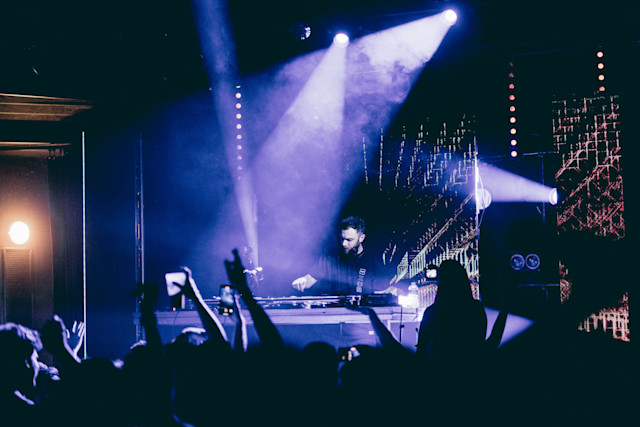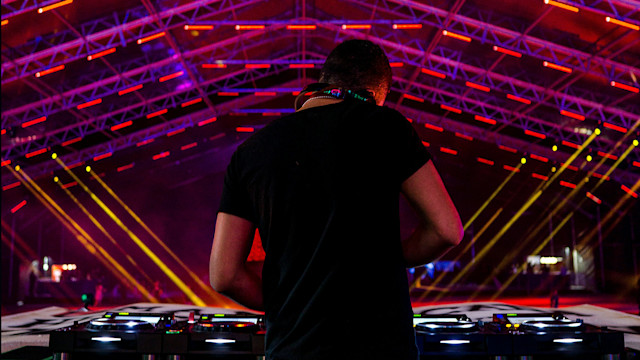How to Make Techno Music - Pro Tips for Beginners
August 9, 2024 - Immerse yourself in the world of Techno. Discover the secrets to creating addictive beats and immersive atmospheres. From Detroit's origins to current trends.

The Infinite Loop of Rhythm
"Techno is an inner journey, an exploration of the mind and body."
Richie Hawtin.
Techno is a genre that has evolved from the darkened dance halls of Detroit to the world's biggest festivals. Its signature sound, marked by repetitive beats, deep bass and minimalist melodies, has captivated millions of people. But what makes a techno track truly special?
In this guide, we'll explore the fundamental elements of techno production, from building solid beats to creating immersive atmospheres. We will unveil the secrets of the sonic alchemy that has made techno one of the most influential musical genres of the last decades.
A Journey to the Heart of Techno
"We wanted to create something new, something no one had heard before. We wanted to make people dance."
Juan Atkins.
Before delving into the fundamentals of techno, it is essential to understand its roots. Techno emerged in the 1980s in Detroit, a city marked by its industrial environment and rich musical heritage.
Pioneers such as Juan Atkins, Derrick May and Kevin Saunderson-known collectively as the Belleville Three-mixed the futuristic sounds of European electronic music with the soulful grooves of American funk, creating a new, hypnotic genre that would conquer the world.
The growth of techno was also fueled by the rave culture in Europe during the late 1980s and early 1990s, especially in cities like Berlin and London. These urban centers became techno epicenters, hosting underground parties that celebrated freedom and unity through music.
The relentless beats and minimalist structure of techno became the soundtrack of a generation that sought to transcend through dance.
The Beat of the Machine: The Kick Drum
The kick drum is the beating heart of any techno track. Its initial impact and prolonged resonance are the foundations on which the whole sonic edifice is built.
Explore different types of kicks: from the hard-hitting trance kicks to the softer, more melodic minimal techno. Learn how to EQ, compress and saturate your kick to give it the character you are looking for.
Remember, a good kick should not only sound good, but it should fit perfectly with the rest of the elements of the track.
Advanced Beat Programming
Beat programming is fundamental in techno production. Explore different techniques such as:
Roll hi-hats: create complex and varied hi-hat patterns. You can use different hi-hats to generate different sonorities, try to be objective when adding elements, do it if you think it's necessary and be careful not to overproduce your track.
Accentuation of the bars: Use accents to give more groove to your beats.
Rhythmic polyphony: Combine different percussive instruments to create rich and complex textures. Lean on syncopated rhythms and try to make all the elements as a whole support each other and not fight each other.
The Bass Line: The Engine That Drives
The bass is the backbone of techno. A well-designed bass line can make a track move and breathe. Experiment with different waveforms, synths and effects to create basslines that are both powerful and melodic. The relationship between bass and kick is fundamental: they must complement and contrast at the same time.
The Melody: A Spectral Essence
In techno, melodies are often simple and repetitive, but no less powerful for that. Learn to build melodies using scales and chord progressions that resonate with the groove of the track.
Explore the use of arpeggiators and sequencers to create complex and evolving melodic patterns. Remember, a good melody should not only be pleasing to the ear, but should evoke emotion and create an atmosphere.
The melody is usually the element of the track that conveys the most emotions, so you can keep in mind when creating what emotions you want to convey and thus be able to make certain decisions and save yourself a lot of time.
The Texture: Weaving a Tapestry of Sound
Texture is what gives depth and dimension to a techno track. Pads, effects, and atmospheric sounds are essential tools for creating rich, immersive soundscapes.
Explore the use of reverbs, delays, and other modulation effects to create infinite sonic spaces. Parameter automation is a powerful way to add movement and dynamics to your tracks.
The Structure: The Listener's Journey
The structure of a techno track is like a journey. It starts with a smooth intro, builds tension through a build-up, explodes into a powerful drop and resolves with a breakdown or outro.
Learn how to use different arrangement techniques to create structures that are both predictable and surprising.
Structure of a Typical Techno Track
A typical techno track usually follows a basic structure consisting of:
Intro: A smooth, atmospheric section that sets the tone for the track.
Build-up: A section in which the intensity gradually increases, creating tension and anticipation.
Breakdown: A section in which the intensity decreases, creating a moment of respite before the climax.
Drop: The climax of the track, where the most energetic and catchy elements are introduced.
Break: A shorter and repetitive section that serves to maintain the energy after the drop.
Outro: A section that closes the track in a satisfactory way, often with a repetition of the most important elements.

The Mix: The Last Piece of the Puzzle
A balanced and clean mix is essential to make your track sound professional. Learn how to use the EQ, compressor and limiter to control the level of each element and create a cohesive soundscape. Reference is key: compare your mix with professional tracks to identify areas for improvement.
This step is fundamental and takes time to master, just take your time, study each process you want to apply and the different techniques most used in the industry, over time you will realize that you will be mastering more techniques and your ear will be trained to make the best decisions.
Read more: Pro Guide: How To Mix Your Songs Online in 10 Steps
The Diversity of Techno: A World of Possibilities
Techno is an extremely broad and diverse genre, with numerous subgenres that have emerged over the years. Each subgenre has its own distinctive sound and its own history. Some of the most popular subgenres include:
Detroit techno: The original sound, characterized by its melodic bass lines and futuristic atmospheres.
Minimal techno: A subgenre characterized by simplicity and repetition, with a focus on creating hypnotic atmospheres.
Acid techno: A subgenre characterized by the use of the Roland TB-303 and its acidic, distorted sounds.
Hardcore techno: A faster and more aggressive subgenre, with accelerated rhythms and thumping bass.
Tech house: A subgenre that combines elements of techno and house, with more house beats and more vocal melodies.
Ambient techno: A more atmospheric and relaxed subgenre, with spacey sounds and enveloping textures.
Unleashing Creativity: Practical Tips for Techno Producers
Techno-production is as much an art as it is a science. While technique is fundamental, the real magic comes when we connect with our intuition and let our creativity flow freely. Here are some practical tips to get inspired and find your own sound:
Explore different genres: Don't limit yourself to techno. Listen to jazz, classical, rock, world music and any other genre that catches your attention. Musical diversity will broaden your sound palette and allow you to discover new textures and rhythms that you can incorporate into your productions and create a different style.
Create an inspiring work environment: Design a production space that invites creativity. Use soft lighting, scented candles or any other element that relaxes and inspires you.
Collaborate with other artists: Connect with other producers, share your ideas and learn from their experiences. The techno community is a place where you can grow and develop as an artist.
Keep an idea journal: Write down all your ideas, no matter how crazy they may seem. You can come back to them later and develop them. Nowadays we can take advantage of simple tools like our cell phone, walk down the street and record that idea that suddenly comes to your mind, or even record that sound you came across and use it as a sample for your next beat.
Use idea generation tools: There are numerous apps and tools that can help you generate musical ideas randomly. Also use sound libraries, it is the most useful tool to start producing and practicing. You can use the entire sound bank offered by Soundtrap to create EDM.
Don't be afraid to experiment: Try new sounds, virtual instruments and effects. Experimentation is the key to discovering your own sound.
Take breaks: When you feel blocked, take a break and do something completely different. Often, the best ideas come when we least expect them.
Remember, music production is a personal journey. Enjoy the process and don't compare yourself to others. The most important thing is to be authentic and create music that makes you feel good.
The Legacy Continues
In an interview for Resident Advisor magazine, legendary Detroit producer Jeff Mills shared his vision of techno: "Techno is a music that allows you to explore different dimensions. It's music that makes you feel free." Mills emphasizes the importance of experimentation and innovation in techno production, encouraging producers not to be afraid to explore new sonic territories.
Techno is more than a genre of music; it's a way of life, a philosophy. By producing techno, you become a sonic architect, capable of building entire worlds out of simple sounds. Explore new sonorities and share your music with the world. The future of techno is in your hands. What will your contribution be?
About the author
Odiseo is a music producer and mixing and mastering engineer with experience ranging from music creation as a session and concert musician, beatmaker, live sound engineer, and recording engineer, to audio production for short films, providing a broad perspective on technical concepts and musical skills to take music to another level.
Beginnen Sie noch heute mit Soundtrap!